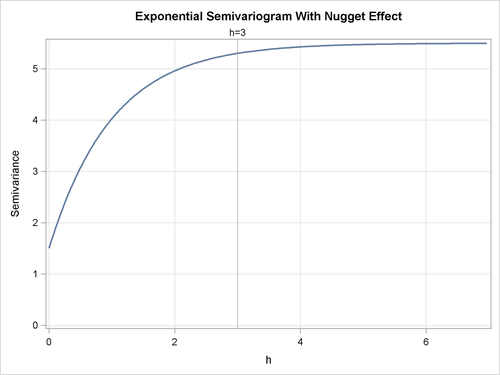The KRIGE2D Procedure
The Nugget Effect
For all the semivariogram models considered previously, the following property holds:
![\[ \gamma _ z(0) = \lim _{h \downarrow 0}\gamma _ z(h) = 0 \]](images/statug_krige2d0083.png)
However, a plot of the experimental semivariogram might indicate a
discontinuity at h = 0; that is,  as
as  , while
, while  . The quantity
. The quantity  is called the nugget effect; this term is from mining geostatistics where nuggets literally exist, and it represents variations at a much smaller scale
than any of the measured pairwise distances—that is, at distances
is called the nugget effect; this term is from mining geostatistics where nuggets literally exist, and it represents variations at a much smaller scale
than any of the measured pairwise distances—that is, at distances  , where
, where
![\[ h_{\mathit{min}} = \min _{i,j}{h_{ij}}= \min _{i,j}{\mid \bm {s}_ i-\bm {s}_ j\mid } \]](images/statug_krige2d0089.png)
Nonzero nugget effects have been associated with conceptual and theoretical difficulties;
see Cressie (1993, section 2.3.1) and Christakos (1992, section 7.4.3) for details. There is no practical difficulty, however; you simply visually extrapolate the experimental semivariogram as  . The importance of availability of data at small lag distances is again illustrated.
. The importance of availability of data at small lag distances is again illustrated.
As an example, an exponential semivariogram with a nugget effect  has the form
has the form
![\[ \gamma _ z(h) = c_ n + {\sigma _0}^2\left[1-\exp \left(-\frac{h}{a_0}\right)\right], h > 0 \]](images/statug_krige2d0090.png)
and
![\[ \gamma _ z(0) = 0 \]](images/statug_krige2d0091.png)
where the factor  is called the partial sill and the sill
is called the partial sill and the sill  .
.
This is illustrated in Figure 67.11 for the parameters  ,
,  , and nugget effect
, and nugget effect  .
.
You can specify the nugget effect in PROC KRIGE2D with the NUGGET= option in the MODEL statement. It is a separate, additive term independent of direction; that is, it is isotropic. The way to approximate an anisotropic nugget effect is described in the following section.
Figure 67.11: Exponential Semivariogram Model with a Nugget Effect 

